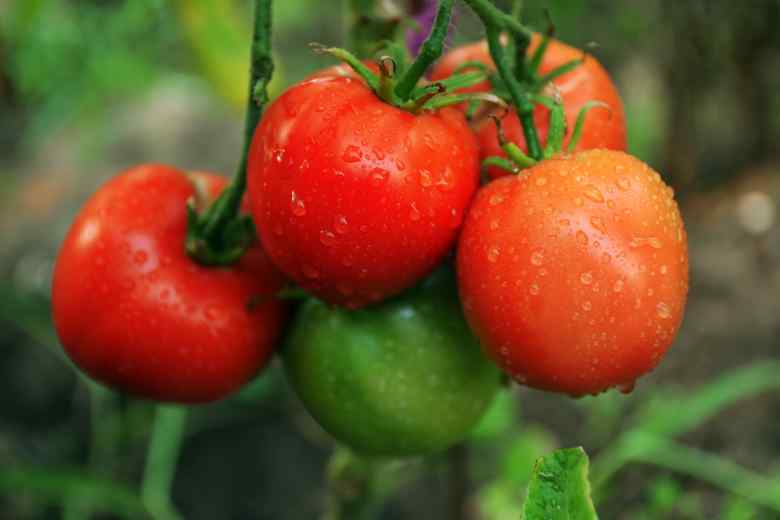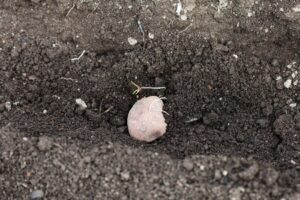
If you’re short on garden space but still want to grow tomatoes, container gardening with 5-gallon buckets is a great option. Since tomatoes can produce an abundant harvest even when grown in buckets, as long as you plant the right number of plants per bucket. Figuring out how many tomato plants to grow in a single 5-gallon bucket is a significant consideration to maximize your yield.
Generally, the exact number of tomato plants that can be grown in a 5-gallon bucket will depend on the variety of tomatoes being grown and the size of the plant, but typically, you should be able to fit 2-4 plants in a single bucket.
While it may be tempting to crowd multiple tomato plants together in a bucket to save space, having too many plants will lead to overcrowding and poor air circulation. This creates the perfect environment for diseases to take hold. It’s better to give each plant enough room to thrive and produce lots of tasty tomatoes.
However, today we will share recommendations for the ideal number of tomato plants to grow in a standard 5-gallon bucket based on the varieties you select. We also provide tips for care and feeding your bucket-grown tomato crop to encourage healthy growth and plentiful harvests all season long.
Keep reading to learn how many tomato plants you can successfully grow in a single 5-gallon bucket! Proper planning and care will have your buckets bursting with homegrown tomatoes in no time.
Planting Instructions for Tomato Plants in 5 Gallon Buckets
When it comes to tomato plants per bucket, less is more. Crowding plants leads to problems like poor air circulation, stunted growth, and increased disease risk.
Most gardeners recommend no more than 2-3 plants maximum per standard 5-gallon bucket. Here are some tips on choosing the right tomato variety and number of plants based on your space.
For a single bucket, stick with determinate or bush tomato varieties which take up less space than vines. Cherry or grape tomatoes are an especially good 1-2 plant per bucket option. Indeterminate or vine tomatoes spread out more, so limit those to only 1 plant per bucket.
If you want to push it a bit, 2 determinate plants or 1 determinate and 1 indeterminate can work in a single bucket as long as you provide sturdy cages or stakes for support. Just be prepared to rotate the bucket weekly for even sunlight exposure.
Three tomato plants per bucket is really pushing the limits of space. I’d save that high density approach only for dwarf or very compact varieties. Most gardeners find 2 plants the perfect balance, allowing both room to thrive without overcrowding issues.
In addition to variety selection, provide tomato plants in buckets with optimal care like a well-draining potting mix, regular fertilizing, and protection from heavy rains or wind. Staking and pruning also encourages more bountiful harvests versus stressed, leggy growth.
Factors Influencing Plant Density:
- Tomato Variety: Different tomato varieties exhibit varying growth habits and sizes. Determinate varieties, which tend to be more compact, may allow for higher plant density compared to indeterminate varieties that can sprawl and require more space.
- Container Size: While we’re focusing on 5-gallon buckets, the depth and width of the container still play a crucial role. Larger containers can accommodate more plants, but over-crowding can lead to competition for resources like water and nutrients.
- Soil Quality: The quality of the soil mix in your bucket is paramount. A well-draining and nutrient-rich mix is essential for healthy tomato plants. Consider adding compost or other organic matter to enhance the soil structure.
Tips for Successful Container Gardening:
Here are some planting instructions for growing tomato plants in 5 gallon buckets:
# Use a high quality potting mix specifically designed for container gardening. It should drain well while retaining moisture.
# Place a layer of gravel or rocks in the bottom of the bucket for drainage. This prevents soil from washing out.
# Fill the bucket 3/4 full with potting mix and gently firm it down.
# Create a small well in the center and place your seedling. Handle plants by their root ball, not the stem.
# Backfill soil around the roots and firm lightly again. Leave room for watering.
# Water well until water drains out the bottom. This settles the soil around the roots.
# Stake or cage your tomato plant for support. Use a stick, cage, or ties attached to the bucket handle.
# Water deeply whenever the top few inches of soil become dry. Check daily.
# Fertilize every 2-3 weeks with a balanced vegetable food following label instructions.
# As the plant grows, prune off bottom leaves and side shoots below first flower cluster.
# Place buckets in full sun for 6+ hours/day for best production. Rotate weekly for even sun exposure.
# Protect buckets from rain and wind which can scour soils and damage plants.
# Following these steps will give your tomato plants in buckets the best start for a productive season!
Supplies Needed to Grow Tomato Plants in 5 Gallon Buckets
Tomato plants can be an economical and fun way to grow your own produce. But to do so successfully, you’ll need the right supplies and setup. For tomato plants in 5 gallon buckets, you’ll need a few essential items.
- Buckets – 5-gallon food-grade buckets specifically. Make drainage holes if needed.
- Potting mix – A general purpose moisture-controlling mix for containers.
- Tomato seeds/seedlings – Select determinate or dwarf varieties.
- Stakes/cages – Support for vines as plants mature, such as bamboo stakes or wire cages.
- Fertilizer – All-purpose liquid plant food or slow-release pellets for continuous feeding.
- Watering can – For thorough watering from above soil level.
- Pruning shears – To remove suckers and shape indeterminate varieties.
- Labels – ID early tomato varieties as they fruit.
- Gloves – For handling plants when staking or maintenance.
- Sunscreen – For protected outdoor garden areas in full sun.
- Mulch – For moisture retention like shredded bark or gravel.
- Pests – Combat common issues using organic methods as needed.
- Trowel – For transplanting and dividing soil.
With the right buckets, soil, support and care essentials, you’ll be all set up for a productive bucket garden and fresh homegrown tomatoes all season long!
Watering and Fertilizing Tomato Plants in 5 Gallon Buckets
Watering and fertilizing tomato plants in 5-gallon buckets is a simple and cost-effective way to grow tomatoes. The buckets provide a deep and wide root zone, and the 5-gallon size is ideal for a single tomato plant.
By filling the buckets with soil, fertilizer, and water, you can ensure that your tomato plants get the nutrients and moisture they need to thrive. The buckets also provide good drainage, which is essential for healthy tomato plants.
Plus, the buckets can be moved around easily, allowing you to get the best sunlight and ventilation for your plants.
With just a few simple steps, you can create a productive tomato garden that will supply you with plenty of delicious tomatoes all season long!
Pest Control for Tomato Plants in 5-Gallon Buckets
Althought growing tomatoes in 5-gallon buckets is a great way to get a large crop of delicious, fresh tomatoes in a small space.
But this convenience can come with a downside – pests. To ensure a successful harvest, pest control for tomato plants in 5-gallon buckets is essential.
Fortunately, there are a few easy steps you can take to keep your tomato plants pest-free. Start by using an insecticidal soap spray to eliminate any sap-sucking pests.
Next, create a homemade garlic pepper spray to discourage any flying pests.
Finally, keep the area around your buckets free of weeds and debris to discourage any other pests. Following these simple steps will help to ensure that your tomato plants remain healthy and pest-free!
Benefits of Growing Tomato Plants in 5-Gallon Buckets
Lets see some key benefits of growing tomato plants in 5-gallon buckets:
1. Flexible gardening space: Buckets allow you to grow tomatoes even if you don’t have a traditional garden area. Just place buckets wherever there is sun.
2. Improved drainage: The bucket design with holes in the bottom prevents soggy soil conditions that can lead to disease issues.
3. Precise watering and feeding: It’s easy to monitor soil moisture levels and provide nutrients directly to the root zone through the top of the bucket.
4. Quicker warming of soil: Plastic buckets heat up faster in spring than in-ground gardens, getting tomatoes started earlier.
5. Portability: Buckets are lightweight when empty, making it easy to move plants around to follow the sun or store over winter.
6. Pest and disease control: Raised off the ground, buckets reduce fungus problems and exposure to some garden pests like slugs.
7. Extends growing season: Buckets can stay warmer than bare ground later into fall for a longer harvest time.
8. Clean up is simple: There is no digging or turning of soil. Just remove old soil and replace with fresh potting mix for a new season.
9. Personalized care: With buckets, it’s easy to tailor watering, nutrients and support to each individual plant’s needs.
For those short on space, 5-gallon buckets truly maximize your tomato-growing options. With the right care, you’ll enjoy a productive harvest!
Conclusion
We hope this post has provided helpful information on successfully growing tomato plants in 5-gallon buckets. By selecting the right variety and quantity of plants per bucket, along with optimized care practices, you can maximize your tomato harvest even in limited space. 5-gallon buckets truly are a versatile and productive option for any vegetable gardener.
Starting with high-quality soil, drainage and plant support are essential to set up your tomato buckets for success. Following recommended watering and fertilizing guidelines throughout the season will keep your plants healthy and fruiting abundantly. With a little know-how and daily care, a few bucketfuls of tomatoes can produce far more than you may expect.





